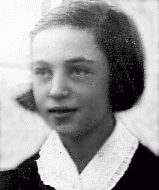You searched for: SEO常用的google工具【TG飞机:@bapingseo】谷歌推广大概费用【TG电报:@bapingseo】斯里兰卡谷歌霸屏【Telegram:@bapingseo】3333tt彩8彩票mg娱乐场4355返水?9XcDlq/846624.html
<< Previous | Displaying results 301-350 of 485 for "SEO常用的google工具【TG飞机:@bapingseo】谷歌推广大概费用【TG电报:@bapingseo】斯里兰卡谷歌霸屏【Telegram:@bapingseo】3333tt彩8彩票mg娱乐场4355返水?9XcDlq/846624.html" | Next >>
-
Frances Perkins
ArticleFrances Perkins was FDR's secretary of labor. Learn about her role in the rescue of European Jews whose lives were threatened by the Nazi regime.

-
Law on the Head of State of the German Reich
ArticleThe Law on the Head of State of the German Reich was the last step in destroying democracy in interwar Germany and making Adolf Hitler a dictator. Learn more.
-
Doriane Kurz describes appell (roll call) in Bergen-Belsen
Oral HistoryDoriane's Jewish family fled to Amsterdam in 1940, the same year Germany occupied the Netherlands. Her father died after deportation to Auschwitz. After their mother was seized, Doriane and her brother hid with gentiles. The three were reunited at Bergen-Belsen, where they were deported via Westerbork. They were liberated during the camp's 1945 evacuation, when Doriane was 9. Her mother died of cancer soon after Doriane helped her recover from typhus. Doriane and her brother immigrated to the United States.
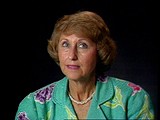
-
Izak Lichtenstein Testimony Excerpt
ArticleRead an excerpt from Izak Lichtenstein’s 1947 testimony about the resistance movement in the Lachva (Lachwa) ghetto.
-
SS: Key Dates
ArticleKey dates in the history of the SS (Schutzstaffel; Protection Squadrons), charged with the leadership of the “Final Solution,” the murder of European Jews.

-
Bergen-Belsen: Key Dates
ArticleExplore a timeline of the history of the Bergen-Belsen camp in the Nazi camp system. Initially a POW camp, it became a concentration camp in 1943.
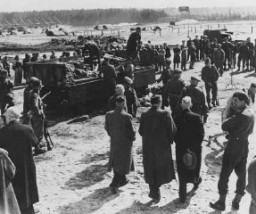
-
The Press in the Third Reich
ArticleAfter rising to power, the Nazis eliminated freedom of the press in Germany. Learn more about how they established control over the press and manipulated it.

-
Stutthof
ArticleLearn about the Stutthof camp from its establishment until liberation in May 1945, including conditions, forced labor, subcamps, and death marches.
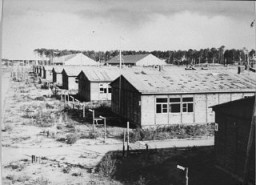
-
Raoul Wallenberg and the Rescue of Jews in Budapest
ArticleSwedish diplomat Raoul Wallenberg led an extensive rescue effort during the Nazi era. His work with the War Refugee Board saved thousands of Hungarian Jews.
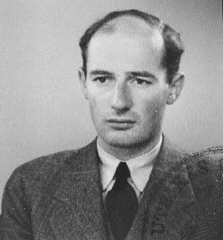
-
Kindertransport, 1938–40
ArticleKindertransport refers to a series of rescue efforts between 1938 and 1940 that brought thousands of refugee children to Great Britain from Nazi Germany.
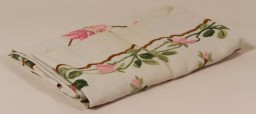
-
Theresienstadt
ArticleThe Theresienstadt camp/ghetto served multiple purposes during its existence from 1941-45 and had an important propaganda function for the Germans. Learn more.

-
Berlin
ArticleBerlin was home to Germany’s largest Jewish community. It was also the capital of the Third Reich and the center for the planning of the "Final Solution."

-
The Evian Conference
ArticleAt the July 1938 Evian Conference, delegates from nations and organizations discussed the issue of Jewish refugees fleeing persecution in Nazi Germany. Learn more
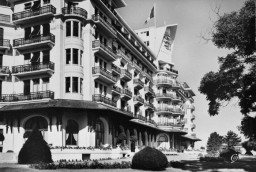
-
Death Marches
ArticleNear the end of WWII, the Germans began marching prisoners out of camps and away from the front. Read more about the brutal conditions of these death marches.

-
Prisoners of the Camps
ArticleJews were the main targets of Nazi genocide. Learn about other individuals from a broad range of backgrounds who were imprisoned in the Nazi camp system.

-
1939: Key Dates
ArticleExplore a timeline of key events during 1939 in the history of Nazi Germany, World War II, and the Holocaust.
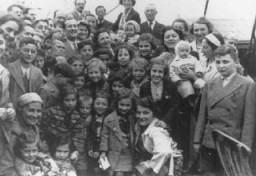
-
Purim
ArticleLearn about the background and traditional observances of Purim, a Jewish holiday marking the deliverance of the Jews from a royal death decree.
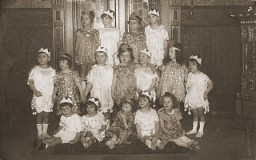
-
The SA
ArticleThe SA (Sturmabteilung) was a paramilitary organization integral to Hitler’s ascension to power. Learn more about the rise and fall of the SA.

-
Mein Kampf
ArticleAdolf Hitler's Mein Kampf (My Struggle) is the best known and most popular Nazi text ever published with over 12 million copies sold from 1925 to 1945.
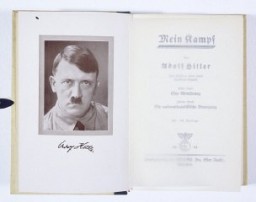
-
Raoul Wallenberg Arrives in Budapest
Timeline EventJuly 9, 1944. On this date, Raoul Wallenberg arrived in Budapest and began his wartime rescue efforts.
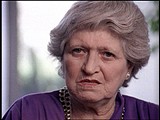
-
German Troops Occupy Hungary
Timeline EventMarch 19, 1944. On this date, Germany occupied Hungary and installed General Dome Sztojay as prime minister.
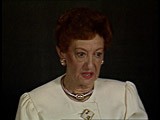
-
Ceasefire Ends Hostilities of World War I
Timeline EventNovember 11, 1918. On this date, a negotiated ceasefire ends the fighting of World War I when it goes into effect at 11am.
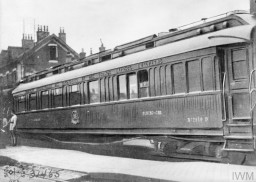
-
Refugees
ArticleThe search for refuge frames both the years before the Holocaust and its aftermath. Learn about obstacles refugees faced when searching for safe havens.

-
Pogroms
ArticleThe term “pogrom” historically refers to violent attacks on Jews by local non-Jewish populations. Learn about pogroms before, during, and after the Holocaust.
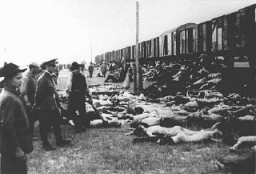
-
Heinrich Himmler
ArticleSS Chief Heinrich Himmler was chief architect of the "Final Solution." Learn more about Himmler, one of the most powerful men after Hitler in Nazi Germany.

-
Inge Scheer
ID CardInge grew up in Vienna's Leopoldstadt, a large Jewish district located between the banks of the Danube Canal and the Danube River. The Scheers loved music, and Inge grew up listening to family members singing selections from popular operettas. 1933-39: Inge was 8 years old when the Germans annexed Austria in 1938 and her parents decided they'd better flee. They were smuggled illegally, via the Netherlands, to Brussels where the Jewish community helped to hide illegal refugees like Inge and her family.…
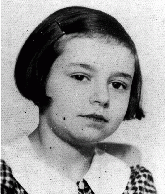
-
Fischel (Philip) Goldstein
ID CardFischel was the youngest of five children. He came from a Jewish family of artisans; his father was a tailor, his uncles were furriers, and his sister was a dressmaker. Fischel started his education at a Jewish parochial school at age 3, where he studied Hebrew and Yiddish. He continued his education at Jewish private schools until age 10, when he entered Polish public schools. 1933-39: After graduating from the Polish public school system at age 14, Fischel started an apprenticeship in his father's…

-
Jozef Rapaport
ID CardJozef was raised in a religious Jewish family. When he was a baby, his father died and his mother was left to care for him and his three older sisters. The family was poor, but Jozef was determined to have a good education. He put himself through university in Prague, and then went on to earn a Ph.D. in economics in Vienna. In 1931 he married Leah Kohl, and the couple settled in Warsaw. 1933-39: The Rapaports lived in the suburbs, and Jozef worked as a banker. His daughter, Zofia, was born in 1933. Jozef…
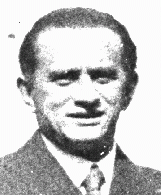
-
Magda Rein
ID CardMagda was the oldest of two children born to observant Jewish parents. They lived in Satoraljaujhely, a town in northeastern Hungary on the Czechoslovakian border. Jews represented some 20 percent of the town's approximately 18,000 persons. Magda's father owned a bakery; her mother was a midwife. 1933-39: At 10 years of age, Magda began accompanying her mother when she attended to births nearby. Her mother helped all women--Jews, Roma (Gypsies) and peasants in the surrounding villages. When Magda was 12,…

-
Zofia Rapaport
ID CardZofia was born to a Jewish family in Warsaw. Zofia's father, a self-made man who had put himself through university, was a successful banker. The Rapaports lived on a street of single-family homes with gardens. Zofia's room was decorated with yellow lacquered furniture. 1933-39: As a young child, Zofia loved to play with her dog, Chapek. Sometimes she got to go shopping with her mother downtown. Each year during the Jewish holiday of Passover her family visited Zofia's grandparents in Lvov. In late August…
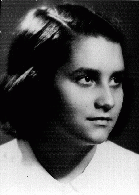
-
Dora Eiger
ID CardDora grew up in the industrial city of Radom, known for its armaments industry. Though fervently Jewish, her Yiddish-speaking parents differed from each other in that her mother was deeply religious while her father was not religious and was an ardent member of the Zionist Labor Party. Also known by her Jewish name D'vora, Dora attended Jewish schools and joined a Zionist youth organization. 1933-39: When Dora visited her uncle near the German border in 1936, she first noticed anti-Jewish placards and…
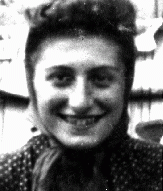
-
Inge Auerbacher
ID CardInge was the only child of Berthold and Regina Auerbacher, religious Jews living in Kippenheim, a village in southwestern Germany near the Black Forest. Her father was a textile merchant. The family lived in a large house with 17 rooms and had servants to help with the housework. 1933-39: On November 10, 1938, hoodlums threw rocks and broke all the windows of Inge's home. That same day police arrested her father and grandfather. Inge, her mother and grandmother managed to hide in a shed until it was…
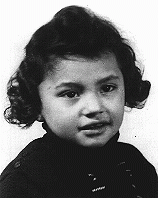
-
Abraham Lewent
ID CardAbraham was born to a Jewish family in the Polish capital of Warsaw. His grandfather owned a clothing factory and retail store, which his father managed. Abraham's family lived in a Jewish section of Warsaw and he attended a Jewish school. Warsaw's Jewish community was the largest in Europe, and made up nearly one-third of the population of the city. 1933-39: After the bombardment of Warsaw began on September 8, 1939, Abraham's family had little to eat. The stores had been reduced to rubble; they had no…
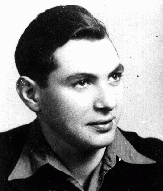
-
Liliana Guzenfiter
ID CardAn only child of middle-class Jewish parents, Liliana was raised in a mixed neighborhood of Christians and Jews in Poland's capital. Her father ran a jewelry business and was a reserve officer in the Polish army; her mother was a housewife. Liliana dreamed of going to the Sorbonne and becoming Poland's second female district attorney. 1933-39: The worst part of going to school was being harassed and called a "filthy Jew." Liliana petitioned to enter a prestigious Catholic high school where she was…

-
Mendel Rozenblit
ID CardMendel was one of six children born to a religious Jewish family. When Mendel was in his early 20s, he married and moved with his wife to her hometown of Wolomin, near Warsaw. One week after the Rozenblits' son, Avraham, was born, Mendel's wife died. Distraught after the death of his young wife and left to care for a baby, Mendel married his sister-in-law Perele. 1933-39: In Wolomin Mendel ran a lumber yard. In 1935 the Rozenblits had a daughter, Tovah. When Avraham and Tovah were school age, they began…

-
Ceija Stojka
ID CardCeija was the fifth of six children born to Roma ("Gypsy") parents who were Roman Catholic. The Stojka's family wagon traveled with a caravan that spent winters in the Austrian capital of Vienna and summers in the Austrian countryside. The Stojkas belonged to a tribe called the Lowara Roma, who made their living as itinerant horse traders. 1933-39: Ceija grew up used to freedom, travel and hard work. Once, her father made her a skirt out of some material from a broken sunshade. She was 5 years old and…

-
Kalman Goldberg
ID CardKalman was one of seven children born to religious Jewish parents in the town of Tarnow. He attended public school in the morning and religious school in the afternoon. Kalman's father owned a factory that manufactured kosher soap, sabbath candles and candles for church altars. The Goldbergs lived above their factory, which was located in a predominantly Jewish neighborhood. 1933-39: The Germans occupied Tarnow on September 8, 1939. The next day, they burned the synagogues. One synagogue, built of stone…

-
Emma Arnold
ID CardEmma was born to Catholic parents in Strasbourg, the capital of Alsace-Lorraine. Her father died when she was 8 years old, and Emma grew up on her mother's mountain farm. At 14 she became a weaver. Later, she married and moved with her husband to the Alsatian town of Husseren-Wesserling. In 1930 she gave birth to a daughter. In 1933 the Arnolds moved to the nearby city of Mulhouse. 1933-39: Emma and her family decided to become Jehovah's Witnesses. Emma felt she was blessed with a loving husband and…
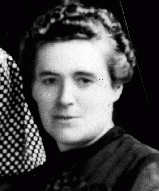
-
Helene Gotthold
ID CardHelene lived in Herne and Bochum in western Germany, where she was married to a coal miner who was unemployed between 1927 and 1938. Following their disillusionment with the Lutheran Church during World War I, Helene, who was a nurse, and her husband became Jehovah's Witnesses in 1926. Together, they raised their two children according to the teachings of the Scripture. 1933-39: Under the Nazis, Jehovah's Witnesses were persecuted for their missionary work and because they believed their sole allegiance…

-
Magdalena Kusserow
ID CardOne of 11 children, Magdalena was raised as a Jehovah's Witness. When she was 7, her family moved to the small town of Bad Lippspringe. Her father was a retired postal official and her mother was a teacher. Their home was known as "The Golden Age" because it was the headquarters of the local Jehovah's Witness congregation. By age 8 Magdalena could recite many Bible verses by heart. 1933-39: The Kusserow's loyalty was to Jehovah, so the Nazis marked them as enemies. At 12 Magdalena joined her parents and…

-
Hilde Verdoner-Sluizer
ID CardHilde was raised in a middle-class Jewish family in Amsterdam. Like many of the Netherlands's Jews, Hilde's family was well-integrated in Dutch society. Hilde excelled in high school, especially in languages. After graduation, she studied homemaking for two years, and then took a job as a secretary in Rome. Hilde returned to Amsterdam where, at 24, she married Gerrit Verdoner in December 1933. 1933-39: After their wedding, Hilde and Gerrit moved to Hilversum, a residential town in the heart of the…
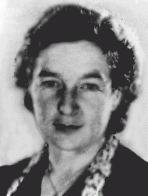
-
Betty Leiter Lauchheimer
ID CardBetty was one of 14 children born to a religious Jewish family in Aufhausen, a village in southwestern Germany. Her father was a successful cattle dealer in the area. On May 8, 1903, at age 20, Betty married Max Lauchheimer, a cattle merchant and kosher butcher. They lived in a large house by an orchard in the village of Jebenhausen. Betty and Max had two children, Regina and Karl. 1933-39: In late 1938 Betty and Max were visiting their daughter in Kippenheim when police arrested Max and their son-in-law.…
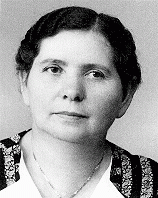
-
Harry Toporek
ID CardHarry was one of eight children born to a large Jewish family in the Polish town of Lask, 18 miles southwest of Lodz. The Toporeks operated a tannery. Harry attended a public school in the mornings and a religious school in the afternoons. After graduating from secondary school, Harry helped his family in the tannery. 1933-39: On Friday, September 1, 1939, Germany invaded Poland, and by Sunday German planes began bombing Lask. Harry and his family couldn't fight the planes so they fled into the fields.…
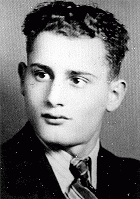
-
Margit Nemeth Fekete
ID CardMargit was born to a Jewish family in the city of Szentes. In 1919 she married and had a son, Gyorgy. When Gyorgy was still a baby, Margit divorced, but she remarried several years later. Her new husband, Vilmos Fekete, worked as a manager in a large electric company in Ujpest, a suburb of Budapest. Margit settled there and her son stayed in Szentes with his grandparents. 1933-39: Margit and her son saw each other as often as possible. Margit would travel by bus to Szentes to spend the Jewish holidays…
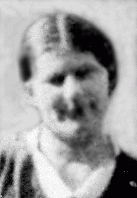
-
Jermie Adler
ID CardThe second of seven children, Jermie was born to poor, religious Jewish parents at a time when Selo-Solotvina was part of Hungary. Orphaned as a young boy, he earned a living by working at odd jobs. In the 1920s he married a woman from his village. Together, they moved to Liege, Belgium, in search of better economic opportunities. There, they raised three daughters. 1933-39: In Liege the Adlers lived in an apartment above a cafe, and Jermie and his wife ran a successful tailoring business. Their children…
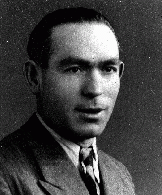
-
Zelda Piekarska
ID CardZelda was born to a close-knit Jewish family in Sosnowiec, a city in the coal-mining region of Poland. Her father owned a restaurant and also co-owned a chocolate and candy factory. Zelda loved to dance; she was an excellent tap dancer. 1933-39: On September 4, 1939, the Germans entered Sosnowiec. Zelda's family was at her father's store when the German tanks rolled down the street. She saw people lying on the ground but didn't understand why. Her mother told her they were dead. Later, the Germans forced…
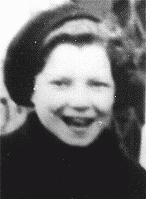
-
Guta Blass Weintraub
ID CardGuta was born to a Jewish family in the Polish city of Lodz, the nation's second-largest city and the center of its textile industry. Her father, a successful businessman, owned a clothing factory, which produced uniforms for the Polish army. Guta attended a private Jewish school in Lodz. 1933-39: On September 1, 1939, not long after Guta began secondary school, the Germans invaded Poland. Polish soldiers moved quickly through Lodz to defend the border, but a few days later, after being beaten, they came…
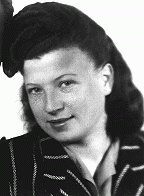
-
Shaye Rothkopf
ID CardShaye's town in the province of Lodz had a Jewish community that comprised almost one-third of the town's population. Shaye was very young when his father died during World War I. Afterwards, his grandparents helped to support his family. When Shaye was a teenager, his mother died. He and his siblings then lived with their grandparents. 1933-39: Swimming was Shaye's favorite pastime and he'd go with his friends to the banks of the Vistula River on every possible occasion. He worked in Lodz for a company…

-
Janina Prot
ID CardJanina's parents had converted from Judaism to Catholicism in the 1920s. When Janina was 4 years old, her parents divorced; Janina left Warsaw and went to live with her father near the Polish town of Radom, while her brother Tomas remained in Warsaw with his mother. Janina, or Jana as she was affectionately known, loved to read. 1933-39: When Jana was 12 she moved back to Warsaw to attend secondary school, and stayed with her mother. A year later, on September 8, 1939, the Germans were bombing Warsaw.…

-
Lifcia Najman
ID CardLifcia and her brother and two sisters were born to religious Zionist parents in Radom, a major center of Polish leather production. The city had more than 100 tanneries and shoe factories. Lifcia's father worked as a leather broker, matching manufacturers with clients who sought specific types of leather. The Najman family lived in a two-room apartment in the center of town. 1933-39: At secondary school, Lifcia learned math, science, Polish language, history, and German. Three times a week she attended a…
